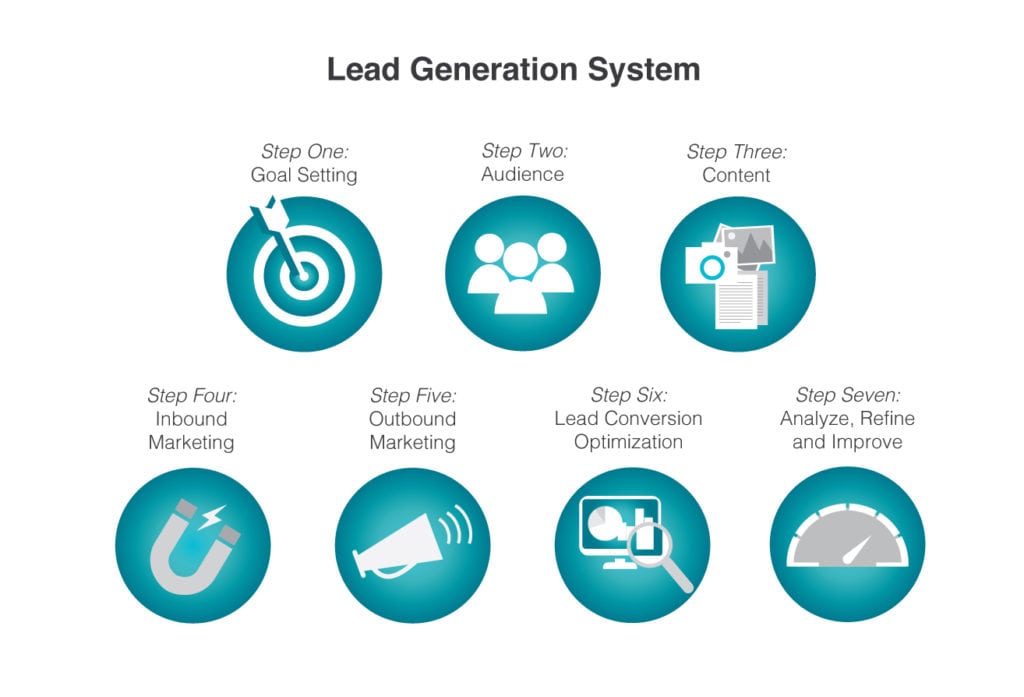How to Implement a Lead Generation Program in 7 Steps

How to implement a lead generation program is top of mind for most business-to-business organizations. A lead generation system is the surest path to more customers and revenue.
The challenge for many is balancing the need to complete current projects with the investment of time required to build a pipeline of future opportunities. Or maybe you have the time but don’t know how to establish an efficient and effective lead-generation system.
We’ve developed a proven, seven-step lead-generation system that’s designed specifically for business-to-business firms.
Step One: Goal Setting
Lead generation success begins with the ‘end’ in mind – determining how much will be spent and what results are expected. During this step, you should:
- Develop revenue and client-acquisition targets for the next 12 months
- Determine the lead generation budget
- Establish lead generation metrics, including the total number of site visitors, goal completions, traffic sources, visitor conversion and cost per conversion
- Identify any additional quantitative or qualitative objectives
Step Two: Audience
A lead generation program can’t be successful without a detailed understanding of the target market. During this step, you should:
- Define your ‘ideal’ client(s) and develop detailed personas
- Develop an understanding of the buying process of your ideal client(s) and determine the key rational and emotional purchase drivers
- Identify any other stakeholders that may influence the evaluation and purchase process of the economic buyer
Step Three: Content
Creating content that’s valued by your target market, builds trust, and moves them closer to becoming a client are the objectives of step three. During this phase of the system, you should:
- Determine the types of content most valued by your target market
- Take inventory of your existing content ‘assets’ that can be repurposed
- Identify the ‘trigger events’ that cause your ideal client(s) to search for the type of services you offer
- Explore topics that you or your firm could ‘own’ or view as experts/thought leaders
Step Four: Inbound Marketing
Inbound marketing involves creating and distributing content that adds value to prospective clients, is less disruptive than traditional marketing, and reaches buyers when they are looking for the service you offer. During this step, you must:
- Determine the optimal content distribution platforms to reach your target market (blog, social media, webinars, podcasts, news media, trade publications, presentations, etc.)
- Set up social media platforms and manage content creation and distribution
- Create a detailed content calendar
- Offer recommendations for search engine and social media advertising (pay-per-click)
- Outline strategies to grow an in-house, opt-in database of prospective clients
Step Five: Outbound Marketing
The ability to measure and refine nearly every facet of inbound marketing has made it a powerful tool for generating leads and growing revenues. However, there is still an important role for traditional, outbound marketing. During this step, you should:
- Identify which outbound marketing tactics would contribute most to lead generation objectives (email, direct mail, banner/online advertising, traditional advertising, sales calls/presentations, etc.)
- Recommend the best methods to market to existing clients to sell additional services and cultivate referral opportunities
- Develop a plan to implement select outbound marketing strategies over the subsequent 12 to 24 months
Step Six: Lead Conversion Optimization
To maximize the value of every sales opportunity, your website and other lead-conversion opportunities must be optimized. During this step, you need to:
- Evaluate your current website and implement design, development and content changes to improve lead generation, tracking and conversion
- Ensure your site’s code, structure and SEO make it easily found by leading search engines
- Create a Google – My Business page and help secure online customer reviews
Step Seven: Analyze, Refine and Improve
By analyzing real-time data, a lead-generation program can be refined and results improved over time. A commitment to continuous improvement can result in a lead generation program that gets better and delivers superior results, month after month. During this final step, we:
- Provide monthly metrics that detail the effectiveness of lead generation efforts and recommend specific initiatives to improve the volume/quality of leads and create more conversions (clients)
- Measure progress against goals and budget
- Outline any additional measures necessary to meet lead generation objectives